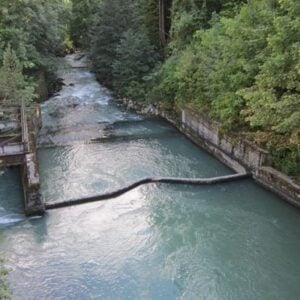In the Western Balkans, floods in the Drin River Basin, which spans Albania, North Macedonia, and Montenegro, have long threatened communities, farmland, and infrastructure. With climate change accelerating, these floods are becoming more frequent, severe, and destructive, putting farmers, families, and small businesses at heightened risk. Residents like Robert Tonaj in Shkodër, Albania, have seen livelihoods destroyed as floodwaters inundate gardens and homes, illustrating the profound social and economic impact of the region’s growing flood hazards.
To address this challenge, Albania, Montenegro, and North Macedonia launched a regional flood management initiative in 2019, supported by the Adaptation Fund and UNDP. This six-year, $9.15 million project sought to move from fragmented responses toward a coordinated, basin-wide strategy for climate-resilient flood management. The project focused on strengthening flood risk information through enhanced monitoring networks and advanced forecasting models, improving national and basin-level flood management policies, and investing in community-level resilience through structural and non-structural measures, including embankments, drainage systems, early warning systems, and ecosystem restoration.
The Drin River Basin, covering around 20,000 square kilometers and home to over 1.6 million people, is ecologically significant, featuring unique lakes such as Ohrid and Shkodra. However, poor land management, deforestation, and aging infrastructure exacerbate flood risks, causing an estimated $10 million in annual damages. Communities across the basin face economic and social vulnerability, particularly in rural and mountainous areas.
In Albania, rehabilitation of the KK-5 drainage channel and implementation of nature-based solutions are helping protect farmland, homes, and livelihoods along the Buna River. In North Macedonia, restoration of the Sateska River has reduced sediment flow into Lake Ohrid, addressing ecological concerns while lowering flood risks for surrounding communities. Montenegro has reinforced the Gropat–Štodra embankment in the Bojana/Buna River basin, safeguarding thousands of residents and thousands of hectares of farmland, while local responders received upgraded flood-response equipment.
The project’s success lies in regional collaboration, creating a shared flood risk management strategy, harmonized with EU standards and informed by community input. Over 33 hydrometeorological stations were installed or upgraded, providing real-time monitoring and GIS-based risk mapping that allow authorities to issue early warnings and plan targeted interventions. The initiative has protected around 7,000 hectares of farmland and strengthened local flood action plans, post-disaster assessment tools, and municipal preparedness.
By focusing on long-term resilience rather than reactive crisis management, the Drin River Basin project offers a model for other transboundary river systems worldwide. Beyond infrastructure, the project strengthens institutions, planning capabilities, and community preparedness, demonstrating the benefits of coordinated action across borders in the face of climate-induced flood risks. Support from UNDP, the Global Environment Facility, the Global Water Partnership Mediterranean, and UNECE continues to bolster sustainable transboundary cooperation in the basin.






